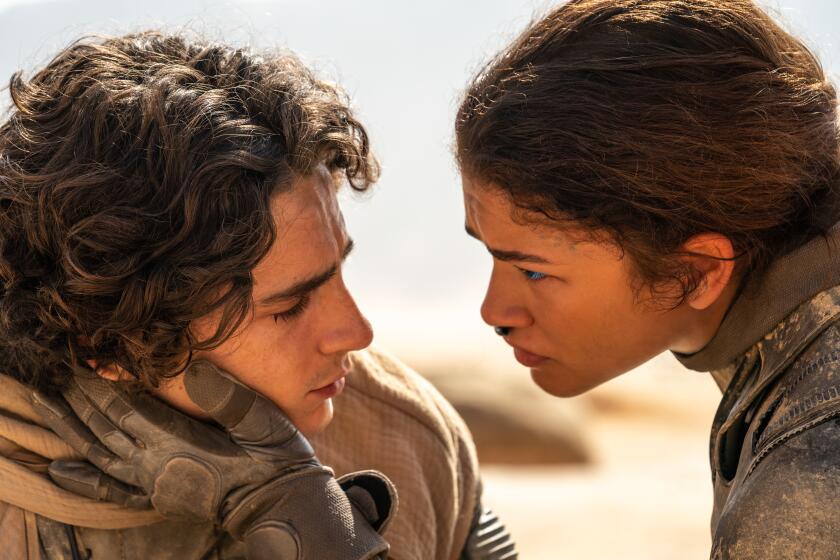The Envelope: We gathered six directors, including Quentin Tarantino and Ridley Scott, in a room. Here’s what they said.
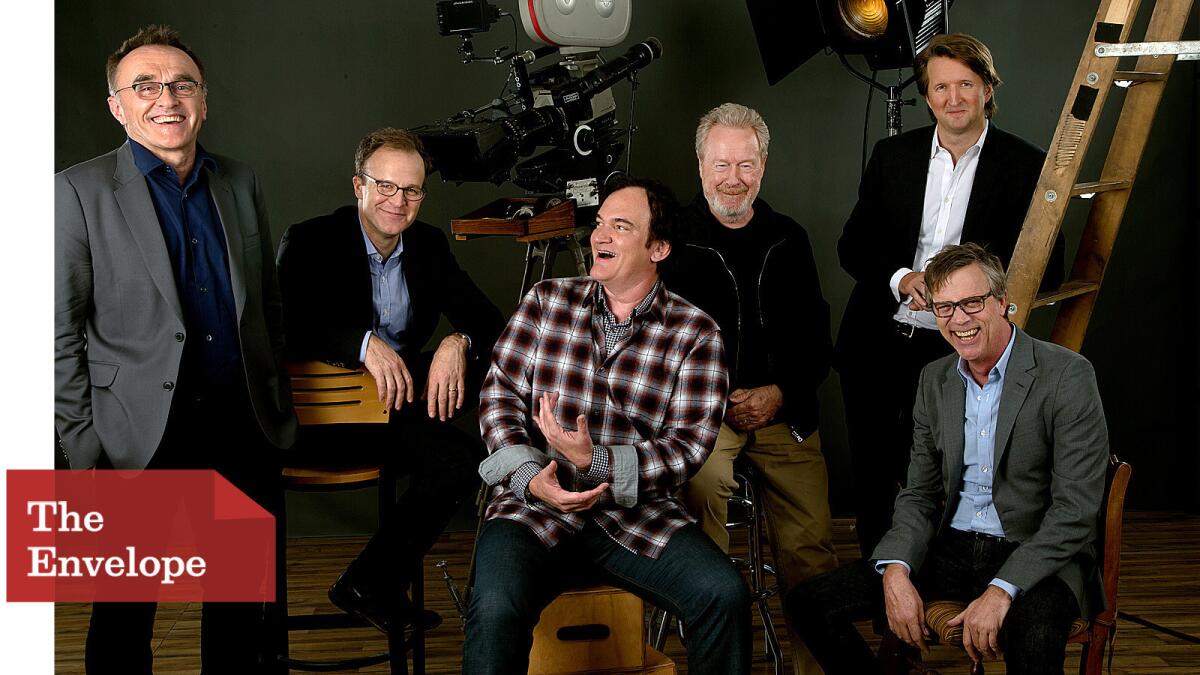
- Share via
Filmmaking is a collaborative art. Yet most movie directors work alone, in the sense that there is only one. So when a group of directors get together to talk about how they do what they do, it is with a genuine interest and curiosity in how others might approach the same problems and situations.
The Envelope gathered such a group last month filmmakers whose work this season crossed centuries, continents and outer space. Participating were Danny Boyle, director of Apple founder movie “Steve Jobs”; Todd Haynes, director of the period love story “Carol”; Tom Hooper for the historical drama “The Danish Girl”; Tom McCarthy for the church investigation film “Spotlight”; Ridley Scott of the adventure “The Martian”; and Quentin Tarantino, director of the post-Civil War “The Hateful Eight.”
Here are edited excerpts from their conversation moderated by Times film writers Rebecca Keegan and Mark Olsen in which these six directors engage one another on the importance of factual and historical accuracy, working with composers and editors, getting the most from actors and how they might approach getting started today.
Mark Olsen: Tom, on your film “Spotlight” there’s a real attention to detail and to the reality of the story you’re telling of a group of reporters working at the Boston Globe. Why was that something that was important you?
See the most-read stories in Entertainment this hour >>
Tom McCarthy: I think early on we had this sort of commitment to craft, to process, and we spent so much time with these reporters and then detailing every element, some of them really interesting, some of them wildly tedious — we kind of geeked out on it a little bit. And we found all these little elements, whether it was going down to the library and going through the old clips or finding old journals and spending two weeks poring over them, we just found it really interesting and compelling. That was kind of an early decision that we gambled would be compelling to audiences and maybe possibly be very boring if we didn’t do it right.
Rebecca Keegan: Ridley, did you take a similar approach to science in “The Martian”? How much did you worry about really being accurate?
Ridley Scott: I didn’t worry at all. I do as little research as possible and I trust the writer and I trust the book. And both the book and writer were excellent, so I said to [screenwriter Drew Goddard], “Is this all accurate?” He said, “It is.” I said, “Thank God for that.” And so we just got on with it. But, I mean, if I didn’t understand anything, I’m like a child with a pencil. I draw. And I draw the right way through the movie. So anything that was scientific that would be boring to speak about I figured had to be illustrated.
Olsen: Danny, your film, “Steve Jobs,” is based on true events but is a purposely fictionalized telling of those events. Why tell the story that way?
Danny Boyle: We always used to say none of this happened but it’s all true. I mean, basically it was a portrait rather than a photograph. It’s a kind of interpretation by a dramatist, Aaron Sorkin, and the rest of us, of an extraordinary character. Obviously, the same six people don’t turn up 40 minutes before each of the launches over three different years, you know? That’s not going to happen. But you want that to happen in a drama.
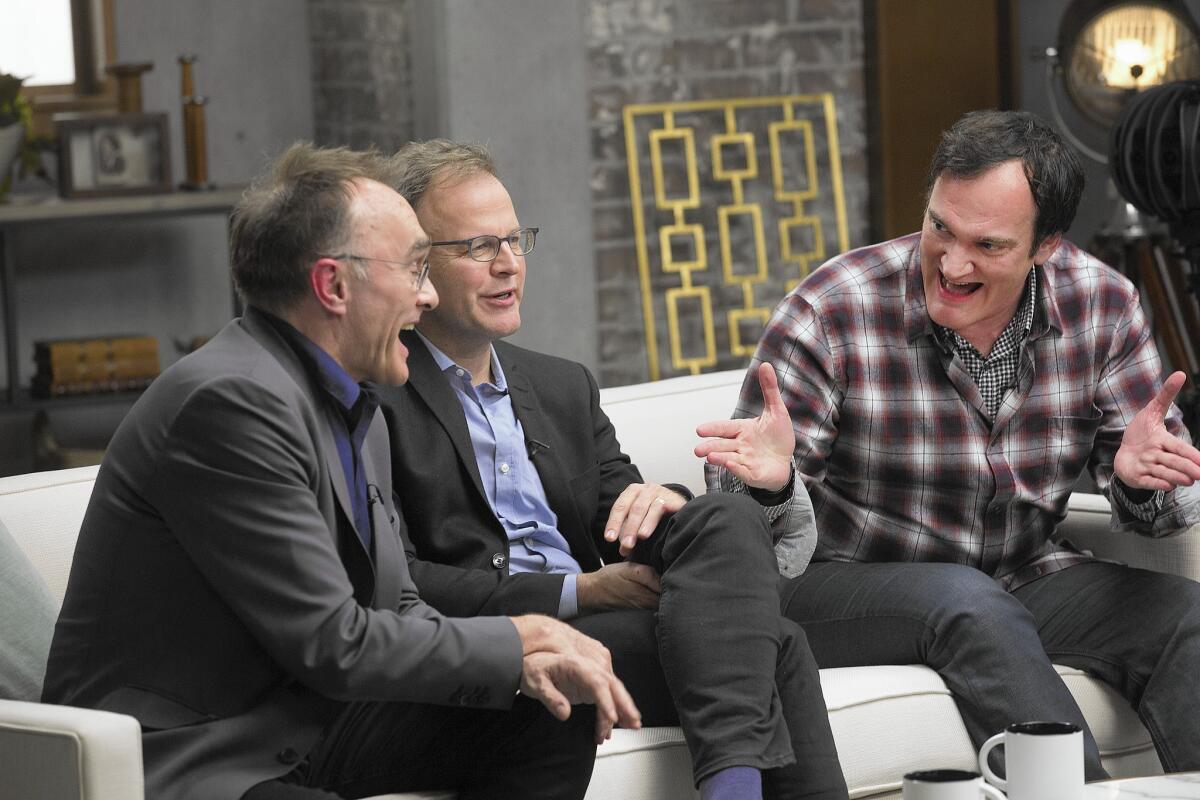
Olsen: “The Danish Girl” is based on a true story; it takes place in a very specific time, a very specific place. So how much of that attention to period accuracy was a concern?
Tom Hooper: I think it was an interesting contradiction because on the one hand the film is surprisingly topical at the moment for a film that’s set almost 100 years ago. And yet a lot of the dramatic tension revolves around really understanding the time frame you’re in because this was the 1920s, where the word “transgender” didn’t exist, where the medical establishment consistently pathologized anyone having that sort of sense of gender identity and would threaten them with locking them up or lobotomizing them or irradiating them. And there was no kind of road map to transition. So it felt like really understanding how extraordinary it was for Lili to emerge and transition at that time when there was no kind of precedent for her doing it made the story much more dramatic. And I think staying true to the time for me just upped the dramatic stakes hugely.
Keegan: Todd, did you face something similar on “Carol” in that this is based on a novel written in the ‘50s? Audiences at that time would have a very different understanding of gay and lesbian issues. The way we talk about them has changed so much. Did you have a similar sense of creating the stakes for a contemporary audience?
Todd Haynes: Well, it started with this amazing novel by Patricia Highsmith, her second novel, “The Price of Salt,” which I didn’t even know existed. We think of her as a crime novelist — because it was very personal and she published it under a pseudonym through most of her lifetime. But it’s all in that book, her experience, her kind of acute tracking of the experience of falling in love through the eyes of the younger character in “Carol” played by Rooney Mara, the character Therese. So that gave us the sort of foundation. And I just felt like I didn’t need to keep thinking about how its relevance has to be proved or demonstrated to a contemporary audience if you just are true to the characters and true to the situations.
Keegan: Quentin, you worked with someone on this film who you wanted to work with for a long time, composer Ennio Morricone. What was it like for you to have that experience?
Quentin Tarantino: Oh, it was really interesting. It was terrific just going to his lovely apartment in Rome and getting together with him and his wife. They both translated the script into Italian. They both read it. I think she liked it even more than he did, which was a good thing. But it was also a really different experience for me because I’d never really worked with one composer before, doing original music. And I’ve used his music a bunch of times but it’s never been original.

In this 2015 Envelope Directors Roundtable, Tom Hooper, Danny Boyle, Todd Haynes, Tom McCarthy, Ridley Scott and Quentin Tarantino chat with L.A. Times reporters Rebecca Keegan and Mark Olsen. Watch for the moment when Tarantino points out that a pl
But the way he did it though, and this is an interesting thing because as much of an artist as he is, he actually wants the director to be comfortable. And so he didn’t, like, score to the movie, like, “Oh, OK, this violin will go like this as this piece of exposition is said.” From reading from the script, he just gave me about 30 minutes of music of what he thought would be appropriate in the piece. And it was up to me to put it in how I saw fit, and I’d always done that before.
Hooper: And the funny thing about music is, I always think that it’s the only thing in a movie that really represents the narrator because everything else is there with the actors. The one thing that’s not there with the actors is the music that you’re playing. And so because it stands in that role, it sort of represents what the filmmaker feels and there’s a real risk that you’ll editorialize in the way you didn’t intend.
Tarantino: It’s one of the reasons I’ve never really trusted anybody to have that kind of power over my movie.
McCarthy: Sometimes it does feel like unfortunately you’re dropping composers in late and they’re playing a little bit of catch-up. And sometimes a composer will do that and really just open my eyes to what I’m locking in on. And Howard Shore did that with me a couple times in “Spotlight” where he was sending me something and I’m, like, that’s way too bold. But then as I sat with it, and the picture was rather unadorned visually so we had to keep pulling back, but then it does push you in a direction that’s exciting.
Keegan: Danny, do you have a strategy for giving a note to an actor?
Boyle: Without it being rebuffed? No. On the “Jobs” film we used a lot of rehearsal time — we actually interrupted the filming to rehearse in blocks, really. I think what you’re looking for is, rather than what I think outsiders think we do, which is like a hugely penetrative note comes in at a certain moment which just reveals everything to everybody, it doesn’t really work like that. You’re looking more for a kind of osmosis transferring your feeling for the film and the concept of the film, the idea of what you’re doing. But you’re also looking to illustrate the best way to suit that, what they have come up with. You know, because then the note feels like it’s organic to them. So it’s more, like, cunning really, kind of almost like pretending to be a director. And actually what you’re doing is you’re kind of illuminating their feelings in the way that best illustrates the story.
Hooper: Eddie Redmayne tells a story that — he said I have something called “the walk.” I said, “What do you mean by ‘the walk’?” And he goes, “Well, basically when you walk from the camera or the monitor to me I can judge by the speed of your walk how many notes you have. If you walk fast it means you’ve got one thing to say. It’s going to be simple. If you walk very slowly, you’re doing an edit of how many of the notes that you actually have that you’re going to give me. So you’re selecting the three from the eight or the three from the six.” And so he’s always in fear of the slow walk because he knows that means I’ve got a lot to say.
McCarthy: [Michael] Keaton used to do this thing to me where you’d be in the middle of a take and I’d just be watching, and I usually let the take run out anyway, but if he didn’t feel good he’d suddenly look right into the camera and go like that [holds up a finger]. And it always freaked me out because you’re so in your world, you’re back by your little camera alone, no one around me. And finally I said, “Why do you keep doing that?” He’s, like, “I don’t want you to stop and call cut.” I’m, like, “I’m never going to call cut but you keep freaking me out.” It was like the reverse of freaking an actor out, so I think I finally got over it.
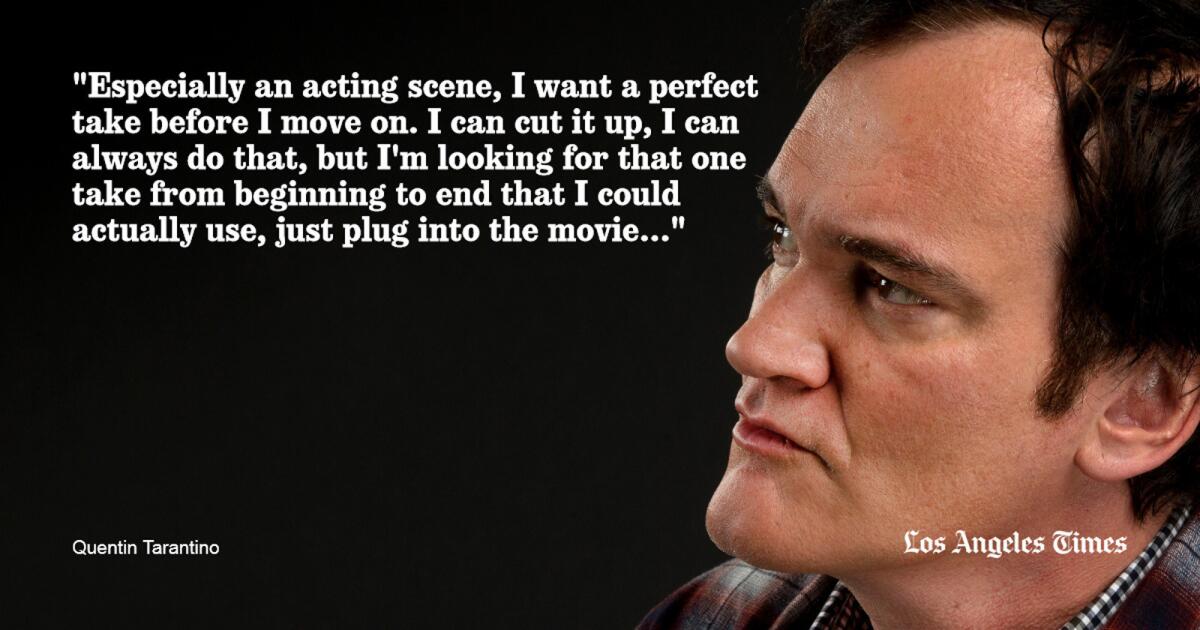
Quentin Tarantino quote
Tarantino: Especially an acting scene, I want a perfect take before I move on. I can cut it up, I can always do that, but I’m looking for that one take from beginning to end that I could actually use, just plug into the movie…
Haynes: But do you mean from the acting or from the camera?
Tarantino: No, from the acting. I want one take from beginning to end that I feel is fairly perfect. And then I want one more that’s, like, a little less perfect.
McCarthy: I feel that too, yeah.
Scott: You don’t take a sneaky look at the lighting and the camera and things like that? I do.
Haynes: I look at the camera, but I also find that actors have different speeds — where some of them, it’s that first take and then others it takes a little time. And so I can’t ever expect that to happen all in that one take.
Tarantino: Not that it makes me different from other people, but … I’ve written the material, and not that I have it necessarily exactly in my head the way I need to hear it, but I do want it, like, on stage, uninterrupted, boom.
McCarthy: But as a writer how good are you — because this is something I struggle with as a writer too — about letting go? Like them interpreting, even on-word. So word-perfect but interpreting a scene where you’re, like, “that is very different than I initially saw it.” Can you let go of that?
Haynes: I find letting go is what you do, you have to learn how to let go at every stage. And because people have asked me — “Carol” is the first film I haven’t written myself and people are, like, “How different is it than films you have written?” And, really, because even when it’s your own script you have to surrender at a certain point to what you get on film and then you surrender from those dailies to what that first cut looks like. And you have to surrender that first cut to what people are starting to say about the cut.
Scott: No, no, no. Not me. I cut as I go. Do you cut as you go?
Tarantino: No, not at all.
Haynes: No, I don’t cut as I go either. I can’t.
Scott: I cut as I go. I go see rushes and then go and see the scene that was done that day.
Haynes: That’s amazing you can do that.
Tarantino: The assembly, that’s literally a moment for my editor to get as familiar with the footage as I am. But it doesn’t start until I walk in the room.
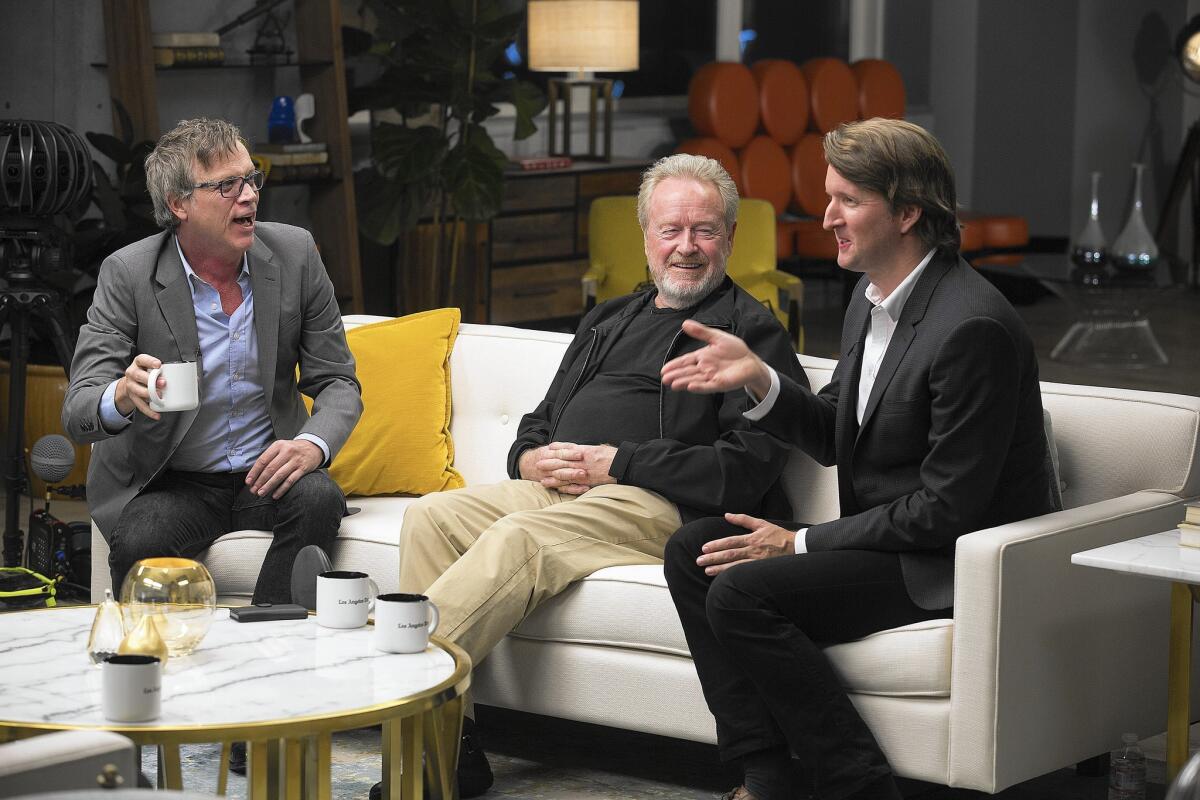
Haynes: Because each thing is like a separate phase. And I want to kind of let the other phase go away and then be completely present for the next one.
Tarantino: Well, I never get into the room and say, “OK, now show me your version of the movie.” What I do though is, like, starting with Scene 1 and working all the way to the end. But even more than that, though, what I need to do is I need, before there was videos and now there’s DVDs, I have all the takes for a given scene that I’m going to use on DVD. And what I need to do is the night before I need to watch all those takes and make all my notes. And I don’t have the script supervisor’s book there because I don’t want to know what scenes were circled or which ones that I like more. I want to — that was then, this is now.
Haynes: Smart.
Tarantino: And then I look at it all and then you find that one take that you love and now you can structure the entire scene around that one take. But I can’t do that in the editing room with him there. I need to do that work at night and then I come in with my notes and here we go.
Keegan: Ridley, when you directed “Alien” it was quite groundbreaking to have a woman out front on a big science-fiction film. Weirdly, it’s still kind of rare. I mean, 30-something-odd years later. What’s the role for directors in that conversation about women on camera?
Scott: You know, I never even thought about it at the time. They thought, “What happens if Ripley is a woman?” I said, “Cool.” And so we just did it and then the reaction at the end of it all was the newness of this idea that you have a female protagonist who emerges through three acts was kind of good. And I thought [Sigourney Weaver] did fantastic, so the film worked very well. And I’ve always had female leads. You know, “Thelma & Louise,” and a very good film with Demi Moore called “G.I. Jane.”
Hooper: But it’s a sad sign of the times that we sit here as six men, you know, and no women directors. And so there’s still clearly a big battle to fight to get women voices as directors to be in the same equal position as men.
Tarantino: I actually remember one of the things that really grabbed me in “Alien” was the fact that I just assumed Tom Skerritt was the star. He was even billed over Sigourney Weaver.
Scott: That was the trick, though.
Keegan: Was there a movie that you walked out of and you said, “I want to do that for a living” — is there one that made you realize you wanted to direct?
Haynes: I remember this moment when I was a kid — because I grew up in L.A. and I was around movies and people who made movies, but it was still going to see my first film as a child, “Mary Poppins,” that just completely had this, you know, exorcistic-like effect on me. But I remember having a fantasy as a kid that one day if I could only walk into a store and ask to see any movie in the world and they would hand it to you over the counter, and I was, like, that would be my dream. And then, you know, 20 years later you’re standing in the video store and you’re looking at all the choices.
McCarthy: And Quentin is behind the counter.
Haynes: And it’s Quentin’s store, or he’s behind the counter. But all of the sudden the fact that they’re all available changes your desire and you feel a kind of weird like, ugh, I want to pick something but I don’t know what I want to pick. But because it’s all there, you know, I wonder what it does to that drive.
Tarantino: I’m of a double-edged sword on that. I mean, I think one of the reasons that there haven’t been one minority filmmaker after another after another after another in the history of America is, one, because of institutional racism, but it is also because of what you’re talking about. You have to convince a whole lot of people to back you and that has to be a thing that you believe can actually happen to you and you can invest 20 years [thinking it can happen] before it ever happens.
The other edge of that sword is the weeding out process of how much do you want it? Are you going to base your entire life for the next 20 years on the chance that might happen? And, you know, you could’ve had the same passion that we all have and just not be able to marshal the troops in order to do the job, but that 20 years of pushing that rock up the hill and not knowing can you ever get there, that is part of it.
Scott: But there’s no excuse today because kids have access to making film — not film, you know — on an iPhone. You can get a camera. If you want to make a film, go make a movie and stop whining.
Hooper: Like “Tangerine,” which was shot on an iPhone.
Scott: “I’ll pay for the hamburgers, we’re going to meet on the pier Saturday morning. You’re going to be Fred. I’m going to be Bill. I’m going to kill you. We’re going to make a movie.” That’s it. And there’s no excuse not to make it.
ALSO
Matt Damon wasn’t all alone as ‘The Martian’ — he had Ridley Scott close by
Matt Damon wasn’t all alone as ‘The Martian’ — he had Ridley Scott close by
Topical films like ‘Spotlight’ want to start conversations, but finding audiences isn’t easy
More to Read
From the Oscars to the Emmys.
Get the Envelope newsletter for exclusive awards season coverage, behind-the-scenes stories from the Envelope podcast and columnist Glenn Whipp’s must-read analysis.
You may occasionally receive promotional content from the Los Angeles Times.










